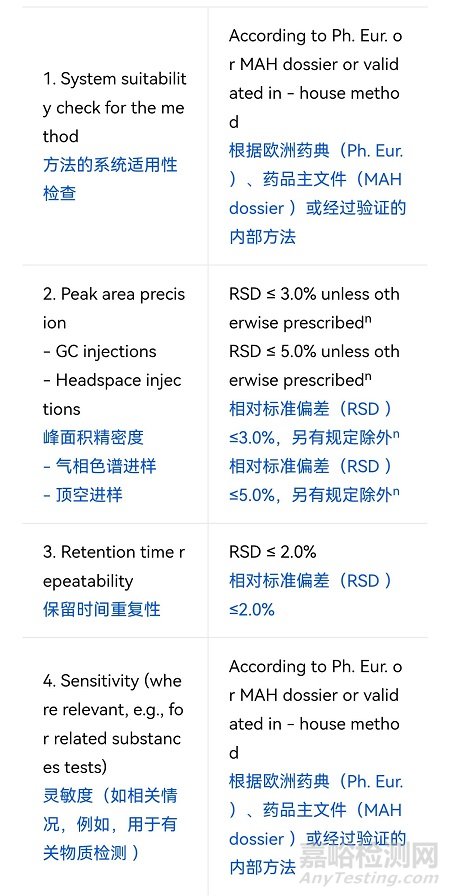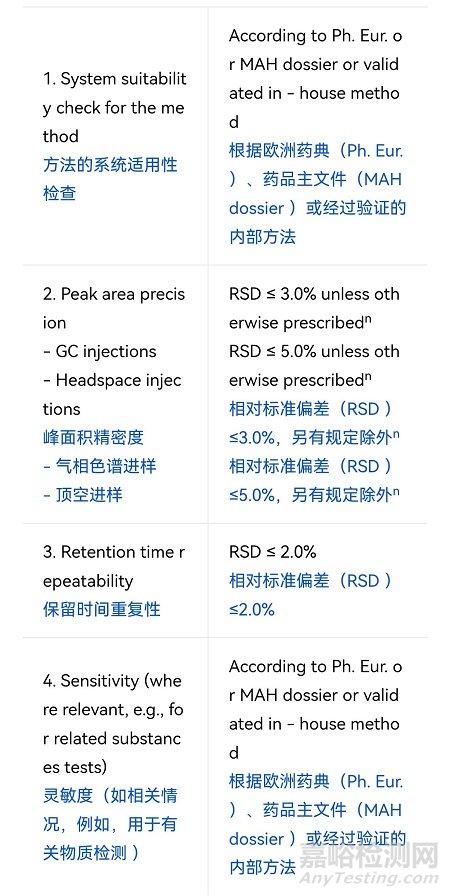您当前的位置:检测资讯 > 法规标准
嘉峪检测网 2025-07-24 19:08
近日,EDQM-OMCL发布了新的《气相色谱仪的确认》指南。该指南包含了实验室气相色谱仪的定期仪器检查、使用中仪器的检查的建议及相关典型接受限度,针对气相色谱仪的定期检查,指南给出了进样口泄漏测试、进样口压力 / 流量准确性及稳定性、气相色谱进样重复性、进样口温度准确性及稳定性、进样口残留、顶空进样重复性、样品瓶加热器温度、柱箱、柱箱温度特性重复性、火焰离子化检测器线性、响应稳定性、噪声与漂移的测试实例及其相关限度。
EDQM 仪器确认指南将仪器的确认分为四个级别(步骤):
LEVEL I 选择仪器和仪器供应商:这一级别涉及到仪器采购的初步阶段,包括确定仪器采购目的、类型 / 型号要求、供应商要求等。设计确认的内容和活动必须有记录,并与仪器档案一起存档。
LEVEL II 仪器安装和使用前验证:这一级别主要关注仪器在实验室环境下的正确安装,并确保实验室的各项条件能满足仪器安装的要求。安装确认的内容和活动必须有记录,并与仪器档案一起存档。
LEVEL III 仪器定期核查:这一级别涉及到仪器的周期性校准和检查,以确保仪器在使用过程中持续满足规定的性能标准。
LEVEL IV 仪器使用中核查:这一级别涉及到在仪器使用过程中进行的核查,以确保仪器性能持续符合检验要求。
气相色谱仪的定期检查:
针对配备火焰离子化检测器(FID)的气相色谱(GC)仪器的建议及相关典型接受限值

使用中仪器的检查:
针对配备火焰离子化检测器(FID)的气相色谱(GC)仪器的建议及相关典型接受限值

该指南翻译如下:
QUALIFICATION OF GC EQUIPMENT
气相色谱(GC)设备的确认
CONTENTS目录
INTRODUCTION.
简介
LEVEL III. PERIODIC AND MOTIVATED INSTRUMENT CHECKS
LEVEL III. 定期及有动机的仪器检查
Recommendations for GC instruments with FID and related typical acceptance limits.
针对配备火焰离子化检测器(FID)的气相色谱(GC)仪器的建议及相关典型接受限度
LEVEL IV. IN-USE INSTRUMENT CHECKS
LEVEL IV. 使用中仪器的检查
Recommendations for GC instruments with FID and related typical acceptance limits.
针对配备火焰离子化检测器(FID)的气相色谱(GC)仪器的建议及相关典型接受限度
LEVEL III. PERIODIC AND MOTIVATED INSTRUMENT CHECKS
LEVEL III. 定期及有动机的仪器检查
4.1. INLET SYSTEM.
进样系统
4.1.1. Injector leak test.
进样口泄漏测试
4.1.2. Inlet pressure/flow accuracy and stability.
进样口压力 / 流量准确性及稳定性
4.1.3. Repeatability of GC injection.
气相色谱进样重复性
4.1.4. Injector temperature accuracy and stability.
进样口温度准确性及稳定性
4.1.5. Injector carry over.
进样口残留
4.1.6. Repeatability of headspace injections.
顶空进样重复性
4.1.7. Vial heater temperature.
样品瓶加热器温度
4.2. OVEN.
柱箱
4.2.1. Repeatability of the oven temperature character stics.
柱箱温度特性重复性
4.3. FID DETECTOR.
火焰离子化检测器(FID)
4.3.1. FID detector linearity.
火焰离子化检测器线性
4.3.2. Constant FID detector response.
火焰离子化检测器响应稳定性
4.3.3. FID detector noise and drift.
火焰离子化检测器噪声与漂移
OVERALL TEST 1.
综合测试 1
OVERALL TEST 2.
综合测试 2
OVERALL TEST 3.
综合测试 3
1. INTRODUCTION
简介
The present document is the second Annex of the core document “Qualification of Equipment”, and it should be used in combination with it when planning, performing and documenting the GC equipment qualification process.
本文件是核心文件《设备确认》的第二个附录,在规划、执行和记录气相色谱(GC)设备确认过程时,应与该核心文件结合使用 。
The core document contains the general introduction and the Level I and II of qualification common to all types of instruments, and the present annex contains GC instrument - related recommendations on parameters to be checked and the corresponding typical acceptance limits, as well as practical examples on the methodology that can be used to carry out these checks.
核心文件包含针对所有类型仪器的一般介绍以及LEVEL I和LEVEL II确认内容,本附录包含与气相色谱仪器相关的、关于待检查参数和相应典型接受限值的建议,以及关于可用于执行这些检查的方法的实际示例 。
Level III (Periodic and motivated instrument calibration/checks) and IV (In - use instrument checks) qualifications must be carried out as an ISO 17025 requirement. The tests proposed in the Level III and IV of qualification are based on an overall approach, in which several parameters are checked at the same time in a controlled test procedure, to obtain information on the instrument performance (e.g., peak area precision, retention time precision, temperature programme reproducibility, etc.).
Level III(定期及有动机的仪器校准 / 检查)和Level IV(使用中仪器的检查)确认必须按照 ISO 17025 的要求执行。Level III和Level IV确认中提议的测试基于一种综合方法,即在受控测试程序中同时检查多个参数,以获得有关仪器性能的信息(如峰面积精度、保留时间精度、温度程序重复性等) 。
Nevertheless, it should be noted that it is also acceptable to check these parameters individually by using other well - defined procedures.
然而,应注意的是,使用其他明确界定的程序单独检查这些参数也是可接受的 。
Requirements and (if applicable) corresponding typical acceptance limits (given in bold) should be applied, however other appropriately justified approaches are acceptable. Exemplary procedures are described in this document, however, it is the responsibility of the user carrying out the required qualification. Nevertheless, it is left to the professional judgement and background experience of each OMCL to decide on the most relevant procedures to be undertaken in order to provide evidence that their GC systems are working properly and are suitable for their intended use. If the qualification of equipment is done by the manufacturer or an external service provider, it is the responsibility of the OMCL to make sure that this is in line with the requirements set out in this guideline.
应应用要求以及(如适用)相应的典型接受限值(黑体字部分),但其他经过适当论证的方法也是可接受的。本文件中描述了示例程序,但执行所需确认的责任在于用户。不过,由各官方药品检验机构(OMCL)根据专业判断和背景经验来决定应采用哪些最相关的程序,以提供证据证明其气相色谱系统运行正常且适合其预期用途。如果设备确认由制造商或外部服务提供商进行,OMCL 有责任确保其符合本指南规定的要求 。
2. LEVEL II. PERIODIC AND MOTIVATED INSTRUMENT CHECKS
LEVEL II. 定期及有动机的仪器检查
Recommendations for GC instruments with FID and related typical acceptance limits
针对配备火焰离子化检测器(FID)的气相色谱(GC)仪器的建议及相关典型接受限值

3. LEVEL IV. IN-USE INSTRUMENT CHECKS
3. LEVEL IV. 使用中仪器的检查
Recommendations for GC instruments with FID and related typical acceptance limits
针对配备火焰离子化检测器(FID)的气相色谱(GC)仪器的建议及相关典型接受限值

This is to be defined in conjunction with the target concentration of the analyte
这应结合分析物的目标浓度来确定
All parameters given here should be checked when performing analyses under the working conditions for the actual sample determinations. Normally, the test and reference solutions to be prepared for this purpose are given as part of the method.
在实际样品测定的工作条件下进行分析时,应检查此处给出的所有参数。通常,为此目的制备的测试和参比溶液作为方法的一部分给出
4. LEVEL III. PERIODIC AND MOTIVATED INSTRUMENT CHECKSLEVEL III.
定期及有动机的仪器检查
Practical examples of tests and their associated tolerance limits for several parameters related to the performance of the different modules of a GC are presented below.
以下给出与气相色谱(GC)不同模块性能相关的几个参数的测试实例及其相关公差限值
These examples can be considered by the OMCLs as possible approaches to perform the Level III of the equipment qualification process: “Periodic and motivated instrument checks”.
这些实例可被官方药品检验机构(OMCLs)视为执行设备确认过程LEVEL 3(“定期及有动机的仪器检查” )的可行方法
Several tests are proposed to check various parameters at the same time (overall tests). In order to run the tests in a more economical way, other suitable solutions can be used, for example, the “Grob Test” mixture, available from different suppliers (e.g. Alltech, Sigma, Thames Restek). This commercial solution should be appropriate to the column material used.
提议进行多项测试以同时检查各种参数(综合测试)。为了以更经济的方式进行测试,可使用其他合适的溶液,例如 “Grob 测试” 混合物,可从不同供应商处获得(如 Alltech、Sigma、Thames Restek)。该商用溶液应与所用的色谱柱材料相适配
It is recommended to run the overall tests by using always the same test material, exclusively dedicated to qualification purposes, to guarantee reproducible conditions.
建议始终使用专门用于确认目的的相同测试材料进行综合测试,以确保条件可重复
It is recommended to run the overall tests by using always the same test column, exclusively dedicated to qualification purposes, to guarantee reproducible conditions.建议始终使用专门用于确认目的的同一根测试色谱柱来进行综合测试,以确保条件可重复
4.1. INLET SYSTEM4.1 进样系统
The following tests are proposed for the periodic and motivated check of the GC Inlet System.以下测试用于对气相色谱(GC)进样系统进行定期和有动机的检查。
4.1.1. Injector leak test4.1.1 进样口泄漏测试
Method方法
If not otherwise specified by the instrument manufacturer, the leak test is carried out according to the procedure laid down in the instrument manual or by the built - in automatic leak check procedure of the instrument.若仪器制造商未作其他规定,泄漏测试应按照仪器手册中规定的程序,或仪器内置的自动泄漏检查程序进行。
Otherwise use the test described below:否则,使用以下测试方法:
Disconnect the column from the injector and close the injector outlet with a sealed cap.将色谱柱与进样口断开,并用密封帽封闭进样口出口。
Close the septum purge and the bypass.关闭隔垫吹扫和旁通。
Adjust the flow and pressure controller to the maximal possible value of the pressure gauge.将流量和压力控制器调节至压力表的最大可能值。
Adjust the flow controller to zero.将流量控制器调至零。
Read the pressure after 1 minute and record the value.1 分钟后读取压力并记录数值。Record the pressure after 5 minutes.5 分钟后记录压力。
Limits限值
Pressure drop ≤ 15 kPa within 5 minutes.5 分钟内压降≤15 千帕。
4.1.2. Inlet pressure/flow accuracy and stability4.1.2 进样口压力 / 流量准确性和稳定性
A direct measurement of these parameters was not deemed practical or necessary, but the optimal conditions of flow/pressure can be verified by the overall test 1.直接测量这些参数被认为不切实际或无必要,但流量 / 压力的最佳条件可通过综合测试 1 进行验证。
Limits: refer to overall test 1.限值:参见综合测试 1。
4.1.3. Repeatability of GC injection4.1.3 气相色谱进样重复性
The verification of this parameter is covered by the overall test 1.该参数的验证包含在综合测试 1 中。
This test is to be performed in both split and split less mode.本测试需在分流和不分流模式下均进行。
Limits: refer to overall test 1.限值:参见综合测试 1。
4.1.4. Injector temperature accuracy and stability4.1.4 进样口温度准确性和稳定性
Due to the fact that the temperature cannot be reliably measured without opening and modifying the system and due to the difficulties of introducing a probe inside this module, the verification of this parameter is considered to be covered by the overall test 2.由于在不打开和改造系统的情况下无法可靠测量温度,且在该模块内插入探针存在困难,该参数的验证被认为包含在综合测试 2 中。
Limits: refer to overall test 2.限值:参见综合测试 2。
4.1.5. Injector carry over4.1.5 进样口残留
After having injected the solutions for the linearity test of the FID detector, in increasing order, inject the blank and measure the peaks that correspond to the major peaks (or analytes) in the linearity solutions.在按递增顺序注入用于火焰离子化检测器(FID)线性测试的溶液后,注入空白样品,并测量与线性测试溶液中主要峰(或分析物)对应的峰。
The verification of this parameter is covered by the overall test 3.该参数的验证包含在综合测试 3 中。
Limits: refer to overall test 3.限值:参见综合测试 3。
HEAD SPACE INJECTORS顶空进样器
4.1.6. Repeatability of headspace injections4.1.6 顶空进样重复性
Method.方法
The GC - HS operating conditions below are provided as an example, adjustments may be needed depending on the equipment used.以下气相色谱 - 顶空(GC - HS )操作条件为示例,可能需要根据所用设备进行调整。
Test solution: 0.5% ethanol in water R (V/V)测试溶液:含 0.5% 乙醇的水(R )溶液(体积 / 体积 )
GC - Settings:气相色谱设置:
Column: 95% Dimethyl / 5% diphenylpoly siloxane 30 m × 0.25 μm, 0.25 mm (HP - 5 was found suitable)色谱柱:95% 二甲基 / 5% 二苯基聚硅氧烷,30 米 ×0.25 微米,0.25 毫米(发现 HP - 5 柱适用 )
Carrier gas: Helium载气:氦气
Column Flow: 1.2 ml/min柱流速:1.2 毫升 / 分钟
Injector temperature: 200 °C进样口温度:200℃
Split ratio: 1:50分流比:1:50
Oven temperature: 40 °C isotherm柱箱温度:40℃恒温
Detector temperature: 250 °C检测器温度:250℃
Run time: 1.5 folds the retention time of the main peak运行时间:主峰保留时间的 1.5 倍
Retention time: about 2.2 min保留时间:约 2.2 分钟
Headspace - Settings:顶空设置:
Carrier pressure: 9.9 psi载气压力:9.9 磅力 / 平方英寸
Vial pressure: 14.2 psi样品瓶压力:14.2 磅力 / 平方英寸
Shake: low振荡:低强度
Oven Temperature: 80 °Coven(顶空炉)温度:80℃
Loop Temperature: 90 °C定量环温度:90℃
Transfer line Temperature: 100 °C传输线温度:100℃
Vial size: 20 mL样品瓶规格:20 毫升
Volume of sample solution/vial: 5 mL每瓶样品溶液体积:5 毫升
Vial Equilibration Time: 15.0 min样品瓶平衡时间:15.0 分钟
Inject Time: 1.0 min进样时间:1.0 分钟
Loop Equilibration Time: 0.1 min定量环平衡时间:0.1 分钟
Loop Fill Time: 0.5 min定量环填充时间:0.5 分钟
Vial Pressurization Time: 0.08 min样品瓶加压时间:0.08 分钟
Carry out 6 consecutive injections of the test solution and calculate the RSD of the different peak areas and retention times.对测试溶液连续进样 6 次,计算不同峰面积和保留时间的相对标准偏差(RSD )。
Limits:限值:
Peak areas: the RSD should be ≤ 5.0%峰面积:相对标准偏差应≤5.0%
Retention time: the RSD should be ≤ 2.0%保留时间:相对标准偏差应≤2.0%
4.1.7. Vial heater temperature4.1.7 样品瓶加热器温度
The heater temperatures are to be set up at values which depend on the operating conditions of the methods applied.加热器温度应根据所采用方法的操作条件设定相应数值。
Suitable calibrated temperature devices are to be used.应使用合适的经校准的温度测量设备。
Put the calibrated device in the oven of the head space compartment. Set the temperature at the required values. When equilibration is achieved, record the value displayed on the calibrated device.将经校准的设备放入顶空进样器的炉腔中。将温度设定为所需数值。达到平衡后,记录经校准设备上显示的数值。
Limits: ± 4 °C from set point限值:与设定点的偏差为 ±4℃
4.2. OVEN4.2 柱箱
4.2.1. Repeatability of the oven temperature characteristics4.2.1 柱箱温度特性的重复性
Due to the fact that the temperature cannot be reliably measured without opening and modifying the system conditions and that even when introducing a probe inside the oven, its location would not reflect the real temperature conditions at all points, the verification of this parameter is covered by the overall tests 2A and 2B.由于在不打开和改变系统条件的情况下无法可靠测量温度,而且即使在柱箱内插入一个探头,其位置也无法反映所有点的实际温度情况,所以该参数的验证包含在综合测试 2A 和 2B 中。
Limits: refer to overall test 2.限值:参见综合测试 2
4.3. FID DETECTOR4.3 火焰离子化检测器(FID)
The following tests are proposed for the periodic and motivated check of the GC FID detector.以下测试用于对气相色谱火焰离子化检测器进行定期和有动机的检查
4.3.1. FID detector linearity4.3.1 火焰离子化检测器的线性
Increasing amounts of analyte are injected and a linear response should be obtained.注入递增量的分析物,应获得线性响应。
The verification of this parameter is covered by the overall test 3.该参数的验证包含在综合测试 3 中。
Limits: refer to overall test 3.限值:参见综合测试 3
4.3.2. Constant FID detector response4.3.2 火焰离子化检测器响应的稳定性
The proper and reproducible functioning of the FID can be demonstrated by checking the peak areas obtained from a pre - defined standard solution.通过检查从预定义标准溶液中获得的峰面积,可证明火焰离子化检测器功能正常且具有可重复性。
The verification of this parameter is covered by the overall test 1 or 2.该参数的验证包含在综合测试 1 或 2 中。
Limits: refer to overall test 1 or 2.限值:参见综合测试 1 或 2
4.3.3. FID detector noise and drift4.3.3 火焰离子化检测器的噪声和漂移
If the instrument has a built - in automatic system for the verification of the noise and drift, follow the manufacturer’s instructions and apply the defined acceptance criteria. Otherwise, use the test described below:如果仪器配有用于验证噪声和漂移的内置自动系统,按照制造商的说明操作并应用规定的接受标准。否则,使用以下测试方法:
Settings:设置:
Column installed安装色谱柱
Suitable flow, depending on column length/diameter合适的流量,取决于色谱柱长度 / 直径
No injection不进样
Oven temperature: 40 °C柱箱温度:40℃
Detector is on and heated at working temperature (270 - 300 °C)检测器开启并在工作温度(270 - 300℃ )下加热
Method方法
After stabilisation of the system, record the signal for 15 minutes.系统稳定后,记录信号 15 分钟。
Noise: evaluate 10 periods of 1 minute and calculate the mean value.噪声:评估 10 个 1 分钟的周期并计算平均值。
Drift: evaluate the slope of the baseline over the 15 minutes.漂移:评估 15 分钟内基线的斜率。
Limits:限值:
The acceptance criteria for these parameters have to be chosen in accordance with the instrument vendor’s instructions and the intended use of the instrument. If no instructions are given, the user has to pre - define these acceptance criteria by taking into account the previous experience and the intended use of the instrument.这些参数的接受标准必须根据仪器供应商的说明以及仪器的预期用途来选定。如果没有说明,用户必须考虑以往经验和仪器预期用途来预先定义这些接受标准。
No fixed values can be pre - defined in this guideline due to the high variety of integration systems used and consequently the acceptance criteria may be expressed in different units (voltage, current, arbitrary units per time).由于所用积分系统种类繁多,本指南无法预先定义固定值,因此接受标准可能以不同单位(电压、电流、每时间任意单位 )表示。
5. OVERALL TEST 15. 综合测试 1
The overall test 1 covers the following parameters:综合测试 1 涵盖以下参数:
Pressure/flow accuracy and stability in the inlet system; Retention time repeatability进样系统中压力 / 流量的准确性和稳定性;保留时间重复性
Repeatability of injection: peak area precision进样重复性:峰面积精度
In split mode分流模式
In split less mode不分流模式
The test may be combined with overall test 3.本测试可与综合测试 3 结合进行。
Split mode:分流模式:
Test solution:测试溶液:
1 - octanol in n - hexane 1% (V/V).正己烷中 1%(体积 / 体积 )的 1 - 辛醇
Settings:设置:
Column: 100% Dimethylpolysiloxane 30m x 0.32mm ID x 0.25μm film (SPB - 1 was found suitable)色谱柱:100% 二甲基聚硅氧烷,30 米 ×0.32 毫米内径 ×0.25 微米膜厚(发现 SPB - 1 柱适用 )
Carrier gas: Helium载气:氦气
Velocity: 25cm/sec线速度:25 厘米 / 秒
Split: 1:100分流比:1:100
Injection: 1μl进样量:1 微升
Injector temperature: 220 °C进样口温度:220℃
Oven temperature: 100 °C isotherm柱箱温度:100℃恒温
Detector temperature: 300 °C检测器温度:300℃
Run time: 1.5 folds the retention time of the main peak运行时间:主峰保留时间的 1.5 倍
Retention time of 1 - octanol: about 5 min1 - 辛醇的保留时间:约 5 分钟
Split less mode:不分流模式:
Stock solution: 1 - octanol in n - hexane 1% (V/V)储备溶液:正己烷中 1%(体积 / 体积)的 1 - 辛醇
Test solution: Dilute 10 ml of the stock solution with n - hexane to 100 ml (corresponds to 1μl/ml of 1 - octanol in n - hexane)测试溶液:取 10 毫升储备溶液,用正己烷稀释至 100 毫升(相当于正己烷中 1 - 辛醇浓度为 1 微升 / 毫升 )
Settings:设置:
Column: 100% Dimethylpolysiloxane 30m, 0.32mm ID, 0.25μm film (SPB - 1 was found suitable)色谱柱100% 二甲基聚硅氧烷,30 米,内径 0.32 毫米,膜厚 0.25 微米(发现 SPB - 1 柱适用 )
Carrier: Helium载气:氦气
Velocity: 30cm/sec线速度:30 厘米 / 秒
Split less injection: purge valve closed during 2 min不分流进样:吹扫阀关闭 2 分钟
Injection: 0.2μl of the test solution进样:0.2 微升测试溶液
Injector Temperature: 220 °C进样口温度:220℃
Oven Temperature: Initial 60 °C for 4 min, 15 °C/min, up to 135 °C, final time 1min柱箱温度:初始 60℃保持 4 分钟,以 15℃/ 分钟升温至 135℃,最终保持 1 分钟
Detector Temperature: 300 °C检测器温度:300℃
Runtime: 1.5 folds the retention time of the main peak运行时间:主峰保留时间的 1.5 倍
Retention time of 1 - octanol: about 8 min1 - 辛醇的保留时间:约 8 分钟
Method:方法:
Carry out 6 consecutive injections of the test solution and calculate the RSD of the different peak areas and retention times.对测试溶液连续进样 6 次,计算不同峰面积和保留时间的相对标准偏差(RSD )。
Limits:限值:
Retention time repeatability: the RSD of the retention times should be ≤ 2.0%保留时间重复性:保留时间的相对标准偏差应≤2.0%
Peak area precision (split and split - less mode): the RSD of the peak areas should be ≤ 3.0%峰面积精度(分流和不分流模式 ):峰面积的相对标准偏差应≤3.0%
6. OVERALL TEST 26. 综合测试 2
The overall test 2 covers the following parameters:综合测试 2 涵盖以下参数:
Injector, oven and detector temperature accuracy and stability: retention time repeatability进样口、柱箱和检测器温度准确性和稳定性:保留时间重复性
Two alternative tests are proposed:提议两种替代测试:
Overall test 2A综合测试 2A
Test solution:测试溶液:
0.03 ml 1 - octanol0.03 毫升 1 - 辛醇
0.03 ml 2 - butanone0.03 毫升 2 - 丁酮
0.035 ml 2,6 - dimethylanilin0.035 毫升 2,6 - 二甲基苯胺
0.035 ml n - tridecane0.035 毫升正十三烷
0.035 ml n - tetradecane0.035 毫升正十四烷
35 mg n - eicosane35 毫克正二十烷
dissolved in 50 ml Dichloromethane溶解于 50 毫升二氯甲烷中
Settings:
设置:
Column: 100% Dimethylpolysiloxane 30m x 0.32mm ID x 0.25μm film (SPB - 1 was found suitable)色谱柱:100% 二甲基聚硅氧烷,30 米 ×0.32 毫米内径 ×0.25 微米膜厚(发现 SPB - 1 柱适用 )
Carrier gas: Helium载气:氦气
Velocity: 25 cm/s线速度:25 厘米 / 秒
Split: 1:100分流比:1:100
Injection volume: 1μl进样体积:1 微升
Injector temperature: 220 °C进样口温度:220℃
Detector: FID检测器:火焰离子化检测器(FID )
Detector temperature: 300 °C检测器温度:300℃
Gradient programme: 60 °C (4 min), 5 °C/min, 270 °C (3 min)梯度程序:60℃(保持 4 分钟 ),以 5℃/ 分钟升温,270℃(保持 3 分钟 )
Method:
方法:
Inject the solution twice and calculate the relative retention (RR) times in relation to n - eicosane (RR = 1)
进样两次,计算相对于正二十烷的相对保留(RR )时间(正二十烷的相对保留设为 1 )
The following table shows the approximately expected relative retention times.
下表显示大致预期的相对保留时间。
|
Analyte分析物 |
1-octanol1 - 辛醇 |
2-octanone2 - 辛酮 |
2,6-dimethylaniline2,6 - 二甲基苯胺 |
n-tridecane正十三烷 |
n-tetradecane正十四烷 |
|
RRT (Relative Retention Time)相对保留时间(RRT) |
0.30 |
0.22 |
0.37 |
0.52 |
0.60 |
Limits:限值:
The RSD of each RR from two consecutive injections should be ≤ 1.0%两次连续两次进样中,每个相对保留值(RR)的相对标准偏差(RSD)应≤1.0%
Overall test 2B综合测试 2B
Test Solution:测试溶液:
1.0% (m/m) n - Nonane and Hexadecane in Tetradecane.正十四烷中含 1.0%(质量 / 质量)的正壬烷和十六烷
Settings:设置:
Column: 100% Dimethylpolysiloxane 25m x 0.32mm ID x 0.52μm film (Ultra - 1 was found suitable)色谱柱:100% 二甲基聚硅氧烷,25 米 ×0.32 毫米内径 ×0.52 微米膜厚(发现 Ultra - 1 柱适用 )
Injection volume: 1μl进样体积:1 微升
Solvent: Tetradecane溶剂:正十四烷
Injection temperature: 250 °C进样口温度:250℃
Gradient programme: 110 °C, 20 °C/min, 180 °C (final time: 3.5 min)梯度程序:110℃,以 20℃/ 分钟升温,180℃(最终保持 3.5 分钟 )
Detector temperature: 250 °C检测器温度:250℃
Injector temperature: 200 °C进样口温度:200℃
Detector: FID检测器:火焰离子化检测器(FID )
Flow rates: as defined by the instrument manufacturer流速:按仪器制造商规定
Split ratio: 1:15分流比:1:15
Split vent: 30 ± 3.0 ml/min分流出口流速:30±3.0 毫升 / 分钟
Septum purge: 3 - 5 ml/min隔垫吹扫流速:3 - 5 毫升 / 分钟
Method:方法:
Allow the system to equilibrate.使系统达到平衡。
Injection sequence:进样序列:
blank (Tetradecane)空白(正十四烷 )
6 replicates of the test solution. Calculate the mean of the retention times and the relative standard deviation of n-Nonane and n-Hexadecane.对测试溶液进行 6 次重复进样。计算正壬烷和正十六烷保留时间的平均值以及相对标准偏差。
Limits:限值:
Retention time repeatability: RSD of the peak retention times of the 6 replicates ≤ 2.0%保留时间重复性:6 次重复进样中峰保留时间的相对标准偏差≤2.0%
Retention time (RT) accuracy: For this example, the retention time ranges shown in the table below are proposed. Nevertheless, individual ranges should be predefined by the laboratory depending on the column used (e.g., Rt. ± 0.2 min).保留时间(RT)准确性:对于本示例,建议采用下表中所示的保留时间范围。不过,实验室应根据所用色谱柱预先定义各自的范围(例如,保留时间 ±0.2 分钟 )。
|
Compound化合物 |
Rt (min)保留时间(分钟) |
|
n-Nonane (C₉)正壬烷(C₉) |
1.3 – 1.71.3 – 1.7 |
|
Tetradecane (C₁₄)正十四烷(C₁₄) |
4.0 – 4.74.0 – 4.7 |
|
Hexadecane (C₁₆)正十六烷(C₁₆) |
5.1 – 6.05.1 – 6.0 |
7. OVERALL TEST 3
7. 综合测试 3
This test is a modified version of the overall test 1 to be used for the verification of:
本测试是综合测试 1 的修改版,用于验证以下内容:
Detector linearity: linearity of the areas recorded检测器线性:所记录峰面积的线性
Detector carry - over: area recorded in the blank run检测器残留:空白运行中记录的峰面积
It is described for both split and split less mode and may be combined with overall test 1.
本测试针对分流和不分流模式进行说明,且可与综合测试 1 结合进行。
Split mode:
分流模式:
Test solution: 1 - octanol in n - hexane 1% (V/V)
测试溶液:正己烷中 1%(体积 / 体积 )的 1 - 辛醇
Prepare further reference solutions by diluting the test solution as described below.
按以下方法稀释测试溶液,制备更多参比溶液。
Settings: see overall test 1
设置:参见综合测试 1
Injection sequence:
进样序列:
5.0 ml of the test solution diluted to 25.0 ml with n - hexane (2 μl/ml): 2 injections取 5.0 毫升测试溶液,用正己烷稀释至 25.0 毫升(浓度为 2 微升 / 毫升 ):进样 2 次
10.0 ml of the test solution diluted to 25.0 ml with n - hexane (4 μl/ml): 2 injections取 10.0 毫升测试溶液,用正己烷稀释至 25.0 毫升(浓度为 4 微升 / 毫升 ):进样 2 次
15.0 ml of the test solution diluted to 25.0 ml with n - hexane (6 μl/ml): 2 injections取 15.0 毫升测试溶液,用正己烷稀释至 25.0 毫升(浓度为 6 微升 / 毫升 ):进样 2 次
20.0 ml of the test solution diluted to 25.0 ml with n - hexane (8 μl/ml): 2 injections取 20.0 毫升测试溶液,用正己烷稀释至 25.0 毫升(浓度为 8 微升 / 毫升 ):进样 2 次
If combined with overall test 1 for repeatability: test solution (10 μl/ml): 6 injections若与综合测试 1 结合进行重复性测试:测试溶液(浓度为 10 微升 / 毫升 ):进样 6 次n - hexane as blank (carry over)正己烷作为空白(用于检测残留 )
Split - less mode:
不分流模式:
Stock solution: 1 - octanol in n - hexane 1% (V/V)
储备溶液:正己烷中 1%(体积 / 体积 )的 1 - 辛醇
Test solution: Dilute 10 ml of the stock solution with n - hexane to 100 ml (corresponds to 1μl/ml of 1 - octanol in n - hexane).
测试溶液:取 10 毫升储备溶液,用正己烷稀释至 100 毫升(相当于正己烷中 1 - 辛醇浓度为 1 微升 / 毫升 )。
Prepare further reference solutions by diluting the test solution with n - hexane.
用正己烷稀释测试溶液,制备更多参比溶液。
Settings: see overall test 1
设置:参见综合测试 1
Injection sequence:进样序列:
5.0 ml of the test solution diluted to 25.0 ml with n - hexane (0.2 μl/ml): 2 injections取 5.0 毫升测试溶液,用正己烷稀释至 25.0 毫升(浓度为 0.2 微升 / 毫升 ):进样 2 次
10.0 ml of the test solution diluted to 25.0 ml with n - hexane (0.4 μl/ml): 2 injections取 10.0 毫升测试溶液,用正己烷稀释至 25.0 毫升(浓度为 0.4 微升 / 毫升 ):进样 2 次
15.0 ml of the test solution diluted to 25.0 ml with n - hexane (0.6 μl/ml): 2 injections取 15.0 毫升测试溶液,用正己烷稀释至 25.0 毫升(浓度为 0.6 微升 / 毫升 ):进样 2 次
20.0 ml of the test solution diluted to 25.0 ml with n - hexane (0.8 μl/ml): 2 injections取 20.0 毫升测试溶液,用正己烷稀释至 25.0 毫升(浓度为 0.8 微升 / 毫升 ):进样 2 次
if combined with overall test 1 for repeatability: test solution (1 μl/ml): 6 injections若与综合测试 1 结合进行重复性测试:测试溶液(浓度为 1 微升 / 毫升 ):进样 6 次
n - hexane as blank (carry over)正己烷作为空白(用于检测残留 )
Limits:限值:
Linearity: coefficient of correlation of the calibration line obtained with the reference solutions and the test solution: r² ≥ 0.999.线性:用参比溶液和测试溶液得到的校准曲线的相关系数:r²≥0.999。
Carry - over: the percentage of the peak area corresponding to the analyte in the blank solution should be ≤ 0.2% of the peak area of this analyte in the chromatogram obtained with the solution with the highest concentration within the sequence.残留:空白溶液中与分析物对应的峰面积百分比,应≤进样序列中最高浓度溶液的色谱图中该分析物峰面积的 0.2%。

来源:GMP办公室


